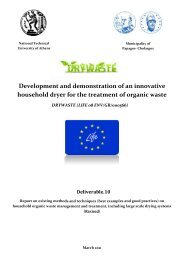MOROCOMP (LIFE TCY05/MA000141) - Unit of Environmental ...
MOROCOMP (LIFE TCY05/MA000141) - Unit of Environmental ...
MOROCOMP (LIFE TCY05/MA000141) - Unit of Environmental ...
You also want an ePaper? Increase the reach of your titles
YUMPU automatically turns print PDFs into web optimized ePapers that Google loves.
2. Factors affecting the composting process<br />
The factors affecting the composting process include: the physical and chemical<br />
properties <strong>of</strong> the raw material, the level <strong>of</strong> oxygen, the moisture content, the<br />
temperature and the time over which the composting process takes place. These<br />
factors are outlined in the following sections.<br />
2.1. Oxygen and aeration<br />
The readily degradable components <strong>of</strong> the raw materials are metabolised during the<br />
initial period <strong>of</strong> composting. Therefore the production <strong>of</strong> heat and the need for oxygen<br />
are greatest at the early stages and then they steadily decrease. Without a constant<br />
supply <strong>of</strong> oxygen, the process will slow down. Approximately a 5% minimum<br />
concentration <strong>of</strong> oxygen is required within the pore spaces (given air contains about<br />
21% oxygen). If there is insufficient oxygen, the process can become anaerobic.<br />
Anaerobic decomposition involves a different set <strong>of</strong> micro-organisms and different<br />
biochemical reactions. Less heat is generated and the anaerobic processes are<br />
potentially less efficient than the aerobic ones. They can generate various substances<br />
and intermediate compounds such as methane, organic acids and hydrogen sulphide.<br />
Many <strong>of</strong> these compounds have strong odours and safety concerns. Although<br />
intermediate compounds, such as organic acids, are formed during aerobic<br />
decomposition, they continue to decompose when oxygen is available. Under<br />
anaerobic conditions, the intermediate compounds can accumulate. A constant supply<br />
<strong>of</strong> oxygen will give the aerobic microorganisms an advantage over the anaerobic<br />
micro-organisms. The existence <strong>of</strong> aerobic conditions is very important in avoiding<br />
the production <strong>of</strong> <strong>of</strong>fensive odours.<br />
Aeration is the process <strong>of</strong> providing oxygen into the composting material, as well as<br />
the mean to remove water vapour, gases and heat trapped within the materials.<br />
Temperature <strong>of</strong>ten is an indicator that determines how much and how <strong>of</strong>ten aeration is<br />
required, given that the required rate <strong>of</strong> aeration for heat removal can be much greater<br />
than that for supplying oxygen. Similarly the aeration rate required to reduce the<br />
moisture content is normally greater than that required for supplying oxygen, but less<br />
than the heat removal rate.<br />
12










